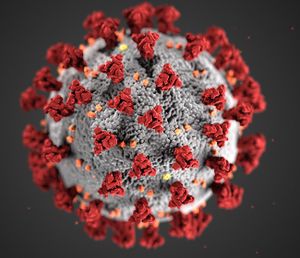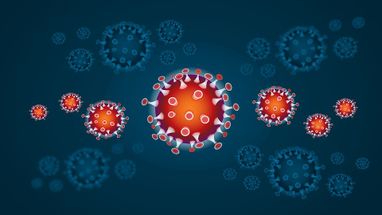Coronavirus Disease (COVID-19)
Original Editor - Tolulope Adeniji.
Top Contributors - Rachael Lowe, Wanda van Niekerk, Kim Jackson, Admin, Lucinda hampton, Nikhil Benhur Abburi, Candace Goh, Tolulope Adeniji, Vidya Acharya, Tarina van der Stockt, Jess Bell, Anas Mohamed, Richard Benes, Nicole Hills, Marleen Moll, Tony Lowe, Olajumoke Ogunleye, Simisola Ajeyalemi, Leana Louw, Oyemi Sillo and Natalie Patterson
Introduction to COVID-19[edit | edit source]
The World Health Organisation (WHO) has declared the coronavirus disease 2019 (COVID-19) a pandemic[1]. A global coordinated effort is needed to stop the further spread of the virus. A pandemic is defined as a “occurring over a wide geographic area and affecting an exceptionally high proportion of the population”[2] The last pandemic reported in the world was the H1N1 flu pandemic in 2009.
On 31 December 2019, a cluster of cases of pneumonia of unknown cause, in the city of Wuhan, Hubei province in China, was reported to the World Health Organisation. In January 2020, a novel coronavirus was identified and samples obtained from cases and analysis of the virus’ genetics indicated that this was the cause of the outbreak. The virus is referred to as SARS-CoV-2 and the associated disease is COVID-19[3]
As of 15 March 2020, over 156,000 cases have been identified globally in 123 countries with a total of over 5,000 fatalities. Live data can be accessed here.
Novel Coronavirus (2019-nCoV) by World Health Organisation, published on 31 January 2020:
WHO: Coronavirus - Questions and Answers by World Health Organisation published on 16 January 2020
This novel coronavirus was named Coronavirus Disease 2019 ( COVID-19) by WHO in Febuary, 2020.[4] This viral diseases, corona viruses, are zoonotic[5] and COVID-19 is not only a contagious respiratory diseases and it can also cause epidemics[6]. Like the Severe Acute Respiratory Syndrome (SARS) virus that first appeared in China, COVID-19 was also first identified in Wuhan, China, in December 2019. Given the fact that this condition can currently be described as a pandemic condition, there is no definitive cure for this disease. Nevertheless, the prevention mechanism by activating the infection control mechanism is necessary to minimise the spread of the disease. Oxygen therapy and other symptomatic treatment of a person with COVID-19 are also standard means of care.
[edit | edit source]
Coronaviruses are a family of viruses that cause illness such as respiratory diseases or gastro-intestinal diseases. Respiratory diseases can range from the common cold to more severe diseases, such as Middle East Respiratory Syndrome (MERS-CoV) and Severe Acute Respiratory Syndrome (SARS-CoV)[7] A novel coronavirus (nCoV) is a new strain that has not been identified in humans previously. Once scientists determine exactly what coronavirus it is, they give it a name (as in the case of COVID-19, the virus causing it is SARS-CoV-2).
Coronaviruses got their name from the way that they look under a microscope. The virus consists of a core of genetic material surrounded by an envelope with protein spikes. This gives it the appearance of a crown. The word Corona means “crown” in latin.
Coronaviruses are zoonotic. This means that the viruses are transmitted between animals and humans. It has been determined that MERS-CoV was transmitted from dromedary camels to humans and SARS-CoV from civet cats to humans[7]. The source of the SARS-CoV-2 (COVID-19) is yet to be determined, but investigations are ongoing to identify the zoonotic source to the outbreak[8].
Clinical Presentation[edit | edit source]
Among those who will become infected, some will show no symptoms. Those who do develop symptoms may have a mild to moderate, but self limiting disease with symptoms similar to the seasonal flu [REF]. Symptoms may include:
- Respiratory symptoms
- Fever
- Cough
- Shortness of breath
- Breathing difficulties
- Fatigue
- Sore throat
- Pneumonia in more severe cases
A minority group of people will present with more severe symptoms and will need to be hospitalised, most often with pneumonia, and in some instances the illness can be so severe that it can lead to death [REF]. Emergency warning signs where immediate medical attention should be sought [REF] include:
- Difficulty breathing or shortness of breath
- Persistent pain or pressure in the chest
- New confusion or inability to arouse
- Bluish lips or face
High Risk Population[edit | edit source]
The virus that causes COVID-19 infects people of all ages. The risk of severe disease gradually increases from 40 years of age. However, evidence to date suggests that two groups of people are at a higher risk of getting severe COVID-19 disease [REF]:
- Older people (people over 60 years of age)
- People with serious chronic illnesses such as:
- Diabetes
- Cardiovascular disease
- Chronic respiratory disease
- Cancer
The World Health Organisation has issued and published advice for these high risk groups and community support. This is to ensure that these high risk populations are protected from COVID-19 without being isolated, stigmatised, left in positions of increased vulnerability or unable to have access to basic provisions and social care.
The WHO has issued advice for high risk populations [REF] :
- When having visitors at your home, extend “1m greetings”, like a wave, nod or bow.
- Request that visitors and those who live with you, wash their hands
- Clean and disinfect surfaces in your home (especially those that people touch a lot) on a regular basis
- Limit shared spaces if someone you live with is not feeling well (especially with possible COVID-19 symptoms)
- If you show signs and symptoms of COVID-19 illness, contact your healthcare provider by telephone, before visiting your healthcare facility
- Have an action plan in preparation for an outbreak of COVID-19 in your community
- When you are in public, practice the same preventative guidelines as you would at home
- Keep updated on COVID-19 through obtaining information from reliable sources
Transmission of COVID-19[edit | edit source]
The incubation period of COVID-19 is between 2 to 14 days.[REF] This means that if a person remains well after 14 days after being in contact with a person with confirmed COVID-19, they are not infected.
Evidence is still emerging, but current information is indicating that human- to- human transmission is occuring. The routes of transmission of COVID-19 remains unclear at present, but from evidence from other coronaviruses and respiratory diseases it can be postulated that the disease may spread through large respiratory droplets and direct and indirect contact with infected secretions.
https://www.youtube.com/watch?v=1APwq1df6Mw
Diagnostic Procedures[edit | edit source]
A Covid-19 diagnostic testing kit has been developed and is available in clinical testing labs. [Ref] The CDC recommends that any person who may have had contact with a person who is suspected of having Covid-19 and develops a fever and respiratory symptoms listed above are advised to call their healthcare practitioner to determine the best of course of action[Ref]. The main criteria for testing are [Ref]:
- cation
- Age
- Medical history and risk factors
- Exposure to the virus and contact history
- Duration of symptoms
If the above criteria are met it is advised that the following testing procedure is followed [Ref]:
- Collect and test upper respiratory tract specimens, using a nasopharyngeal swab
- If available testing lower respiratory tract specimens
- If a productive cough is evident then a sputum specimen should be collected.
- For patients who are receiving invasive mechanical ventilation a lower respiratory tract aspirate or bronchoalveolar lavage sample should be collected
[edit | edit source]
Management / Interventions[edit | edit source]
add text here relating to management approaches to the condition
Differential Diagnosis[edit | edit source]
add text here relating to the differential diagnosis of this condition
Resources[edit | edit source]
add appropriate resources here
References[edit | edit source]
- ↑ World Health Organization. WHO Director-General's opening remarks at the media briefing on COVID-19 - 11 March 2020. Available from: https://www.who.int/dg/speeches/detail/who-director-general-s-opening-remarks-at-the-media-briefing-on-covid-19---11-march-2020 (Accessed 14 March 2020)
- ↑ Marriam Webster Dictionary. Pandemic. Available from:https://www.merriam-webster.com/dictionary/pandemic (Accessed 14 March 2020)
- ↑ Public Health England. COVID-19: epidemiology, virology and clinical features. Available from:https://www.gov.uk/government/publications/wuhan-novel-coronavirus-background-information/wuhan-novel-coronavirus-epidemiology-virology-and-clinical-features (Accessed 14 March 2020)
- ↑ World Health Organization. Director-General's remarks at the media briefing on 2019-nCoV on 11 February 2020. 2020/2/18)[2020-02-21]. https://www. who. int/dg/speeches/detail/who-directorgeneral-s-remarks-at-the-media-briefing-on-2019-ncov-on-11-february-2020. 2020.
- ↑ Chan JF, Lau SK, To KK, Cheng VC, Woo PC, Yuen KY. Middle East respiratory syndrome coronavirus: another zoonotic betacoronavirus causing SARS-like disease. Clinical microbiology reviews. 2015 Apr 1;28(2):465-522.
- ↑ Levine, D., Spratt, H., Hanks, J., & Woods, C., 2020. Novel Coronavirus: A Wake-Up Call For Best Practices In Preventing Pathogen Transmission.[online] Available at: <https://www.apta.org/Blogs/PTTransforms/2020/3/10/CoronaBestPractices/> [Accessed 14 March 2020].
- ↑ 7.0 7.1 World Health Organization. Coronavirus. Available from: https://www.who.int/health-topics/coronavirus (Accessed 14 March 2020)
- ↑ Public Health England. COVID-19: epidemiology, virology and clinical features. Available from:https://www.gov.uk/government/publications/wuhan-novel-coronavirus-background-information/wuhan-novel-coronavirus-epidemiology-virology-and-clinical-features. (Accessed 14 March 2020)








